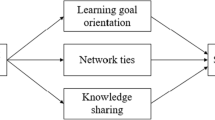Abstract
With growing promotion of 3D technology, Solid Learning (SL) model, featured by construction of individualized context and integration of multidisciplinary knowledge, is increasingly attracting educators’ attention. Although previous research indicated that SL is helpful for improving learners’ innovation, few studies were conducted to examine the driving mechanism, which warrants the further exploration. A total of 58 students were selected to participate in 12-week SL Introductory Landscape Design classes in an university located in the middle of Mainland China. The results of the survey indicated that personalization and interdisciplinary have positive relationship to learners’ creativity in the solid learning settings. Additionally, learners’ interdisciplinary capacity was a partial mediator rather than complete mediator of personalization and learners’ creativity. This research theoretically contributes to explore the driving mechanism of students’ innovation in SL context, and practically many referable values were offered for promoting learners’ creativity.
Access this chapter
Tax calculation will be finalised at checkout
Purchases are for personal use only
Similar content being viewed by others
References
Baker, M., Hong, J., Billinghurst, M.: Wearable computing from jewels to joules [guest editors’ introduction]. IEEE Pervasive Comput. 4(13), 20–22 (2014)
Borja, A., Bricker, S.B., Dauer, D.M., Demetriades, N.T., Ferreira, J.G., Forbes, A.T., Marques, J.C.: Overview of integrative tools and methods in assessing ecological integrity in estuarine and coastal systems worldwide. Mar. Pollut. Bull. 56(9), 1519–1537 (2008)
Brown, C., Hurst, A.: VizTouch: automatically generated tactile visualizations of coordinate spaces. Paper Presented at the Proceedings of the Sixth International Conference on Tangible, Embedded and Embodied Interaction (2012)
Eujin Pei, D., Gatto, A., Bassoli, E., Denti, L., Iuliano, L., Minetola, P.: Multi-disciplinary approach in engineering education: learning with additive manufacturing and reverse engineering. Rapid Prototyp. J. 21(5), 598–603 (2015)
Hong, J., Baker, M.: 3D printing, smart cities, robots, and more. IEEE Pervasive Comput. 13(1), 6–9 (2014)
Hsu, Y., Peng, L.P., Wang, J.H., Liang, C.: Revising the imaginative capability and creative capability scales: testing the relationship between imagination and creativity among agriculture students. Int. J. Learn. Teach. Educ. Res. 6(1), 57–70 (2014)
Hurst, A., Kane, S.: Making making accessible. Paper Presented at the Proceedings of the 12th International Conference on Interaction Design and Children (2013)
Hausman, K.K.: Solid learning files [EB/OL] (2012a). http://www.stemulate.org/2012/05/20/solid-learning-lessons/. Accessed 20 May 2012
Hausman, K.K.: Solid learning files [EB/OL] (2012b). http://www.stemulate.org/2012/05/29/solid-learning-files/. Accessed 29 May 2012
Klein, J.T.: Evaluation of interdisciplinary and transdisciplinary research: a literature review. Am. J. Prev. Med. 35(2), 116–123 (2008)
Manches, A., O’Malley, C.: Tangibles for learning: a representational analysis of physical manipulation. Pers. Ubiquit. Comput. 16(4), 405–419 (2012)
Mueller, S., Mohr, T., Guenther, K., et al.: faBrickation: fast 3D printing of functional objects by integrating construction kit building blocks. In: Proceedings of the 32nd Annual ACM Conference on Human Factors in Computing Systems, pp. 3827–3834. ACM (2014)
NACCCE: All Our Futures: Creativity, Culture and Education. DfEE, London (1999)
Nunnally, J.C.: An overview of psychological measurement. In: Wolman, B.B. (ed.) Clinical Diagnosis of Mental Disorders, pp. 97–146. Springer US, New York (1978)
Piso, Z., O’Rourke, M., Weathers, K.C.: Out of the fog: catalyzing integrative capacity in interdisciplinary research. Stud. History Philos. Sci. Part A 56, 84–94 (2016)
Schelly, C., Anzalone, G., Wijnen, B., Pearce, J.M.: Open-source 3-D printing technologies for education: bringing additive manufacturing to the classroom. J. Vis. Lang. Comput. 28, 226–237 (2015)
Yang, Y., Sun, Z., Zhang, K., Li, A., Sun, R., Gu, J.: Establishing solid learning new teaching mode for petroleum engineering based on CT scanning and 3D printing visualization technology. Exp. Technol. Manag. 32(09), 65–67 (2015). (in Chinese)
Zamora, D., Monsen, K., von Jungenfeld, R.: Crafting public space: findings from an interdisciplinary outdoor workshop on 3D printing. Paper Presented at the Moving Targets Conference Proceedings (2013)
Acknowledgments
Thanks are due to for funding by the National Natural Science Foundation of China (61300060), and the Anhui provincial research projects (foundation NO.: 1508085QF131, 2015zdjy115, 2015zdjy206 & SK2015A632).
Author information
Authors and Affiliations
Corresponding author
Editor information
Editors and Affiliations
Rights and permissions
Copyright information
© 2017 Springer International Publishing AG
About this paper
Cite this paper
Zhai, X. et al. (2017). How Solid Learning Model Influence Learners’ Creativity?—An Empirical Study to Explore the Relationships Between Personalization, Interdisciplinary Capability and Creativity. In: Wu, TT., Gennari, R., Huang, YM., Xie, H., Cao, Y. (eds) Emerging Technologies for Education. SETE 2016. Lecture Notes in Computer Science(), vol 10108. Springer, Cham. https://doi.org/10.1007/978-3-319-52836-6_80
Download citation
DOI: https://doi.org/10.1007/978-3-319-52836-6_80
Published:
Publisher Name: Springer, Cham
Print ISBN: 978-3-319-52835-9
Online ISBN: 978-3-319-52836-6
eBook Packages: Computer ScienceComputer Science (R0)





